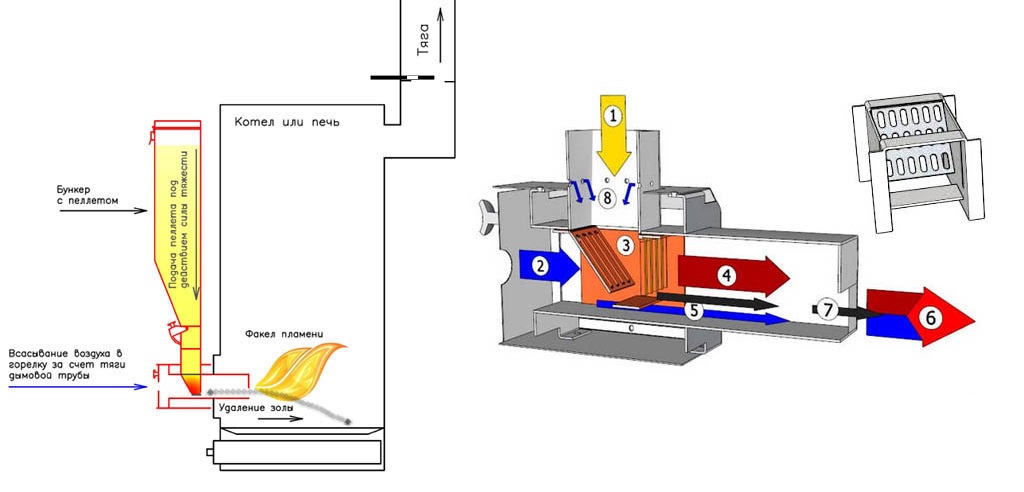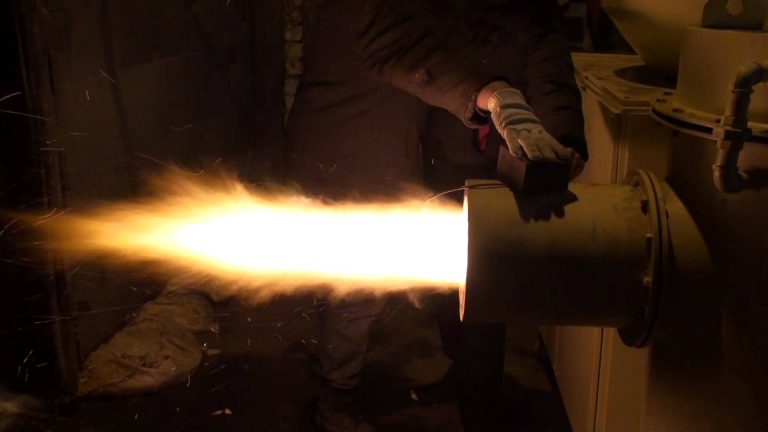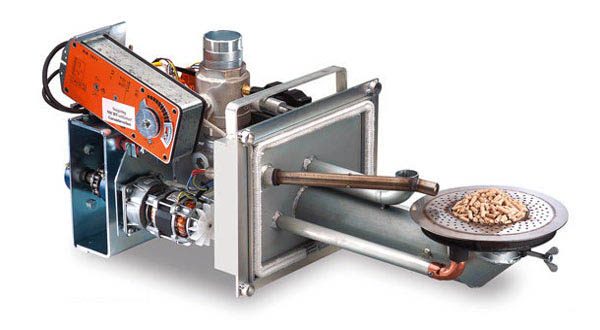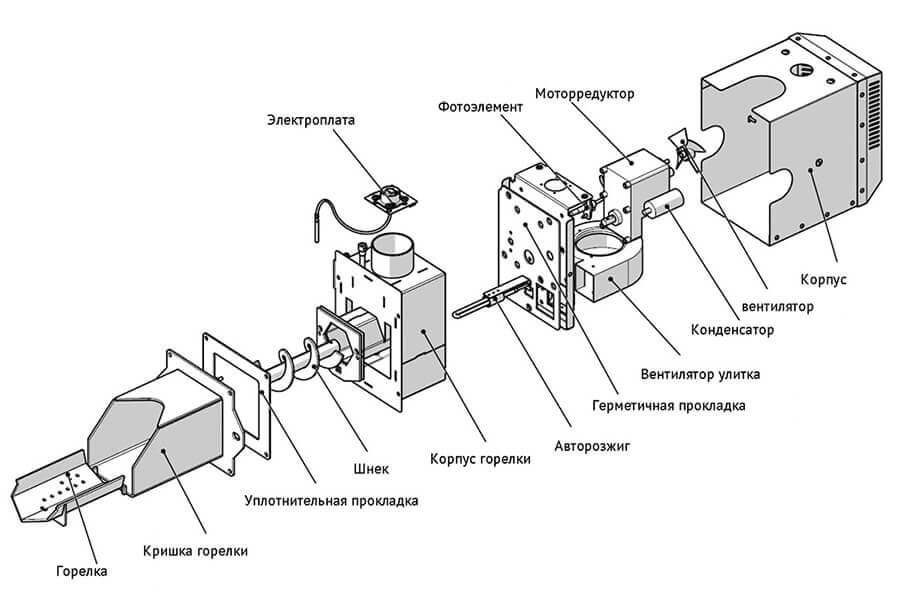The unique smell of natural wood, a clean and decorated room in a modern style - this is what a boiler room in a house can look like if you choose the right equipment. Innovative heat generating equipment that will create the described conditions in the room is a pellet boiler or an automatic pellet burner operating on special fuel pellets, which are created from agro-industrial or woodworking waste.
If a few years ago pellet plants were used only in 20% of houses in Europe, then at the moment the figure has increased to 70%. The use of pellet boilers and burners is the most beneficial option for residential heating from an environmental and economic point of view. Today we will talk about the principles of operation of the equipment, its advantages and disadvantages, and also consider the scheme for making a pellet burner with our own hands.
About the pellet burner
Pellet burner is a special heating device that generates heat by burning pellets or fuel pellets in a boiler. In some cases, these burners use waste dry grain.
There are manual and automatic burners, in automatic burners, fuel is fed into the combustion hopper using a special auger, and the whole process is controlled by sensors, due to which the device needs minimal control from the user. Pellet burners have found their application not only in everyday life, but also in industry. They are used for space heating, water heating and a number of other needs.
Pellets, or fuel pellets, are a special solid fuel that is obtained from wood waste or agricultural production by pressing and granulating under high temperatures.
Pellets are an environmentally friendly type of fuel, since when they are burned, the same amount of carbon dioxide is released into the atmosphere as is formed during the natural decomposition of wood
In countries where agriculture and the woodworking industry occupy a leading position, the cost of pellet fuel is much lower than that of coal. The only exceptions are those regions in the immediate vicinity of which coal mining enterprises are located.
When burning pellets, dangerous fumes are not emitted, as is the case when burning liquid fuels.
Principle of operation
All pellet plants that can be purchased at the store are equipped with additional units:
- Auger - supplies fuel from the bunker to the combustion chamber;
- Controllers for automating the work process;
- Bunker - a place in which the fuel is located before being fed into the combustion chamber;
- The lambda probe is a special sensor that monitors the oxygen content in the smoke chambers and independently controls the fuel combustion process depending on the conditions.
The pellet burner must be protected with a plastic corrugated pipe. It acts as a fuse in the event of reverse thrust. If the fire starts moving towards the bunker, the pipe will burn out, preventing the flame from spreading.
Additionally, a fan is used, which enhances the combustion of pellets by forcing air, as well as a thermoelectric heater, which allows you to ignite the fuel without human intervention.
In automated devices, pellets are fed into the combustion chamber automatically; a person only needs to monitor the amount of fuel in the bunker. The need to supply fuel to the combustion chamber is determined using temperature sensors (they can monitor the air temperature in the room, the water temperature, or any other environmental indicators, depending on the operating mode of the equipment).
The desired temperature of the heat carrier is set by the user, all further increases and decreases are controlled using automated equipment. As soon as the temperature reaches the set level, the burner starts to work in standby mode (the pellets do not go out, they start to smolder). If the temperature, on the contrary, has dropped, the controller activates the built-in fan. Under the action of air, the pellets flare up, the burner goes into operating mode. If during the downtime the pellets go out for any reason, the heating element is activated, which re-ignites.
Device
Any burner has one goal - to create a powerful flame to heat the air or water jacket of the boiler. At the same time, the combustion power itself can be adjusted independently.
The pellet burner has similar goals. The device is a wind tunnel into which solid fuel is supplied and combustion air is forced. Fuel is fed into the pipe using a special screw-type conveyor. The fuel itself before burning is in the hopper. The bunker can have a different volume, and it depends on the volume how long the burner can burn on its own without human intervention (fuel addition).
 Pellet burner device: 1 - The pellet enters the burner under the action of gravity; 2 - Air enters the burner due to the vacuum created by the chimney draft; 3 - Pellet combustion occurs in the combustion chamber, which is called the "basket"; 4 - Due to the high temperature, thermal decomposition of wood occurs in the basket, which forms a flow of combustible gases; 5 - A secondary air flow passes under the basket; 6 - In the burner nozzle, the flow of combustible gases and secondary air is mixed, forming a torch; 7 - Solid combustion products are ejected from the burner into the ash pan of the boiler or furnace by the flow of secondary air; 8 - Ventilation of the supply channel prevents hot gases from diffusing up the channel and destroying the pellet, ensuring a stable supply of pellets.
Pellet burner device: 1 - The pellet enters the burner under the action of gravity; 2 - Air enters the burner due to the vacuum created by the chimney draft; 3 - Pellet combustion occurs in the combustion chamber, which is called the "basket"; 4 - Due to the high temperature, thermal decomposition of wood occurs in the basket, which forms a flow of combustible gases; 5 - A secondary air flow passes under the basket; 6 - In the burner nozzle, the flow of combustible gases and secondary air is mixed, forming a torch; 7 - Solid combustion products are ejected from the burner into the ash pan of the boiler or furnace by the flow of secondary air; 8 - Ventilation of the supply channel prevents hot gases from diffusing up the channel and destroying the pellet, ensuring a stable supply of pellets.
Air is forced into the combustion zone by means of injection by means of a fan.
The combustion chamber in the burner can be round or rectangular. Round burners are the most common due to their ease of manufacture. Outside, a pipe branch pipe is attached to the combustion chamber, through which fuel is supplied from the conveyor.
The design also provides for an ash pan in which combustion wastes accumulate. In the process of burning pellets, a little ash is formed, therefore it is necessary to clean the ash pan no more than once a week with the active use of the burner.
Kinds
There are several types of pellet burners, each of which has its own advantages and disadvantages.
Flare type
Initially, the device was used to generate heat by burning grain, later it was converted to burn solid compressed fuel.
 Flare burner side view
Flare burner side view
- Small overall dimensions;
- Can be used in conjunction with boilers in which the combustion chamber is small;
- Simplified operation;
- Increased reliability;
- Poor quality pellets can be burned.
- Low power compared to other burners;
- The flame is directed horizontally, due to which it heats the boiler locally.
Bulk type
Unlike the previous model, they have increased power and high efficiency. The disadvantages of the device include a complicated design, large overall dimensions, dependence on the quality of the pellets used.
 General view of the volumetric combustion burner
General view of the volumetric combustion burner
Fireplace
 Burning pellets in a fireplace burner
Burning pellets in a fireplace burner
Similar designs are mainly used in domestic conditions, installed in fireplaces and boilers. The principle of operation of the device is as follows: pellets fall into a special bowl, where they are burned under the action of air supplied from below.
The disadvantages of the model include the size of the device and the need for point adjustment for proper combustion.
Advantages and disadvantages
The equipment has several advantages:
- Pellets are a safe fuel compared to gas and electricity;
- Allows you to significantly reduce the cost of space heating compared to using electric boilers. At the same time, pellet plants are more expensive than gas equipment, but do not forget that it is not always possible to conduct gas and purchase gas cylinders;
- Home-made installations guarantee high efficiency - 95%. Some store installations have over 97%;
- They are used not only for heating the room, but also for obtaining hot water;
- There are no regulations for the transport and storage of fuel. Being close to a person, pellets do not cause allergic reactions, and there are no toxic fumes during combustion;
- Fuel is available for purchase. Equipment owners complained about the lack of fuel and the need to prepare a supply of pellets from the winter when devices appeared, now there is no need to store a large amount of pellets at home, they can be bought everywhere if necessary;
- The price of pellets is on average at the same level, unlike gas and electricity, the tariffs for which periodically experience seasonal fluctuations;
- Installation of the device does not require special skills, and it is not necessary to coordinate the installation with the authorized bodies;
- After the combustion of pellets, natural mineral ash is formed, which does not require special rules for disposal.
Along with the advantages of such equipment, there are a number of disadvantages:
- The high cost of finished store equipment. Despite the popularization of devices in recent years and some price reductions, pellet boilers are still more expensive than gas or electric equipment of similar power;
- The equipment needs constant care (especially outdated models). The user will have to clean the ash pan and heat exchanger from the accumulated ash once a week. In modern models, cleaning is provided at the automatic level;
- In the absence of automatic fuel supply, the user has to load the pellets into the bunker manually;
- It is necessary to ensure minimum humidity conditions in the premises where the pellets will be stored while waiting for use;
- Imported equipment is practically not designed for the conditions of a harsh domestic winter, as a result of which breakdowns and malfunctions often occur;
- In remote areas, fuel for the winter still has to be stored due to unstable supplies.
Production of a pellet burner
Pellet plants are often ignored by buyers due to their high cost compared to gas and electric equipment, while the problem is solved by making the device at home.
 General scheme for self-production of a pellet burner
General scheme for self-production of a pellet burner
The combustion chamber can be equipped with a square or round pipe. It is better to give preference to heat-resistant steel that can withstand elevated temperatures, the wall thickness should be at least 4 mm.
The self-made installation is fastened to the boiler with a flange plate made of heat-resistant steel with a thickness of 3 mm or more.
A container for supplying fuel to the combustion chamber can be purchased or made by hand. The best option is to immediately make an installation in which fuel will be supplied automatically. To do this, we place an auger in the purchased pipe of the desired diameter. The rotation of the device will be due to the bearing, gearbox and engine running at low speeds.
Additionally, a fan is purchased in the store, which will pump air. The fan is mounted on a plate, which is made depending on the size and design of the door of the boiler used in your home.
It is also important to take care of adjusting the amount of incoming fuel and the volume of air blown by the fan, otherwise the home-made device will be unstable. In home devices, the adjustment of the air supply force and the number of pellets is done manually. This method is inconvenient due to the fact that it requires constant supervision of the burner.
For automation, an electric incandescent element and a photo sensor are purchased. The first device ignites the flame in case the pellets are extinguished, and also regulates the activation of the device. The photo sensor monitors the appearance of the flame: if the flame is stable, the sensor sends a signal to the incandescent element to stop ignition.
To automate the system, a filling sensor is also purchased. It will notify the electronic filling of the device about the degree of filling of the combustion chamber with pellets.
Pellet burners are modern equipment for boilers that improve the environmental friendliness of the process and reduce fuel costs. At the same time, the equipment itself in the store has a high cost. For basic household needs, it is better to give preference to home-made devices, the operation of which, if necessary, can be automated.
